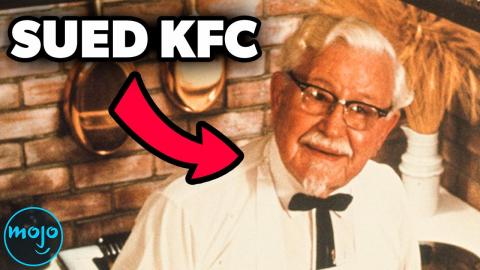Top 10 Food Scandals You Completely Forgot About

#10: Why Bubble Yum Is So Chewy
Top 20 Scandals You Completely Forgot About
Hitting the scene in 1975, it wasn’t long until Bubble Yum was being chewed in schoolyards across America. By its second year on the market, a rumor started to spread regarding the secret ingredient that gave the bubble gum its soft, chewy property: spider eggs! In Florida, manufacturer Life Savers hired private detectives to track down the story’s source, but no luck. In any case, gossip was popping on playgrounds from New York to Los Angeles. Another rumor claimed that the gum caused cancer. While reports vary on how much this affected sales, Life Savers was compelled to take out ads dispelling the rumor. That seemed to do the trick, as Bubble Yum remains a childhood favorite with the spider rumor now a distant memory.
#9: Szechuan Sauce Revolt
The past few years have been so chaotic that it’s easy to forget a simpler time when a Szechuan Sauce shortage was the most prominent controversy. In 1998, McDonald’s added Szechuan Sauce to the menu as a tie-in for Disney’s “Mulan.” The limited-time item fell into obscurity until “Rick and Morty” referenced it in 2017. The buzz inspired McDonald’s to resurrect the sauce six months later, but they made two massive miscalculations. It’d only be available for one day and restricted to selection locations, which were given about 20 packets each. Fans acted about as civilly as you’d expect with one Los Angeles location calling the cops on 300 customers demanding their sauce. The sauce has since returned a few times, but in larger quantities.
#8: The Red M&M’s Scare
Top 10 YouTuber Scandals You Forgot About
Long before Tucker Carlson was waging war against the M&M’s, the colorful candy was at the center of another ridiculous scandal. From 1976 to 1987, you might have noticed that the color red was missing from the M&M’s lineup. That’s because the FDA banned the use of Red Dye #2. Although the Red M&M’s used Red Dye #3 and #40, the candy’s manufacturer discontinued the color due to “confusion and concern.” Orange was introduced as a replacement, but consumers remained nostalgic for red. Occasionally, red returned for holiday packages, leading people to write, “Why do I have to buy a whole year’s supply?” After 11 years, red finally returned as an official color, ironically going on to become the brand’s central spokescandy.
#7: Disgusting Domino’s People
Top 10 Disgusting Food Recalls
In April 2009, Domino’s Pizza went viral for all the wrong (and most disgusting) reasons. In five videos that were posted to YouTube, Domino’s employee Michael Anthony Setzer used his nose and buttocks to seemingly desecrate pizza toppings. His co-worker/accomplice, Kristy Lynn Hammonds, announced that the pies would be sent out. The two underestimated the power of the internet, as the videos soon gained millions of views and attention from the press. Getting fired wasn’t even the more serious repercussion. Charged with a felony for food contamination, both would do jail time and be forced to pay fees. Domino’s eventually recovered from this PR nightmare, but considering how many people continue to ruin their lives on social media, this cautionary tale shouldn’t be forgotten.
#6: Radioactive Oatmeal
Why The Pacific Ocean Might Be Radioactive | Unveiled
Oatmeal is a healthy way to start the day… assuming it isn’t radioactive. Abandoned as a child, Fred Boyce was one of many sent to what is now called the Walter E. Fernald Developmental Center, an establishment for people with developmental disabilities. As you might’ve guessed, the children weren’t treated with the dignity they deserved. Aspiring for a better life, Boyce joined the Science Club, which was entitled to a free breakfast. Little did the students know that their oatmeal contained radioactive tracers. Fed to more than 70 kids, this experiment was part of a “nutrition study” that MIT and Quaker Oats sponsored. Although this happened in the 40s and 50s, it wouldn’t come to light until the 90s when Boyce and others affected received a sizable settlement.
#5: Subway Chicken: Now with 50% Chicken?
Whether it’s a six-inch chicken teriyaki sub or a foot-long chicken breast, it’s only natural for Subway patrons to assume that the chicken in a chicken sandwich is 100%... well, chicken! Imagine their surprise when a Canadian news program conducted a DNA test in 2017, finding only 53.6% chicken in Subway’s oven-roasted chicken and 42.8% in their chicken strips. The rest was mainly comprised of soy. Subway argued that the report was “100% wrong,” reaching out to two independent labs that found less than 1% of soy in the samples provided. Subway proceeded to sue CBC Marketplace for $210 million. The story still wasn’t the best look for Subway, although it’s been widely overshadowed by another scandal that’s still top of mind.
#4: Finger Lickin’ Lawsuit
People often forget that Colonel Sanders was an actual person and not just a fast food mascot. They’ve also forgotten that time the Colonel took KFC to court. Although Sanders sold KFC in 1964, he continued to act as its symbol. Sanders wasn’t pleased that his image was being used to sell new products that he didn’t create, namely a cheaper recipe that replaced his classic chicken. Sanders decided to open a new restaurant: Claudia Sanders, ‘The Colonel’s Lady’ Dinner House. KFC’s parent company Heublein Inc. pursued legal action, but the Colonel wasn’t one to surrender. Sanders retaliated with a $122 million lawsuit against Heublein. Eventually reaching a settlement, Sanders went on to sell ‘The Colonel’s Lady’ restaurant where his original recipe is still served.
#3: Hungry Enough to Eat a Horse
Europe’s food industry was rocked in 2013 when horse DNA was found in beefburgers and lasagnas across various grocery stores. At the center of the controversy was ABP Food Group and its subsidiaries, most notably supplier Silvercrest. In addition to supermarkets, horse meat was linked to Burger King, which had over 500 chains in the area. Burger King conducted DNA tests that found no traces of equine in their product. However, “small trace levels” were found in four samples from the Silvercrest plant. This led to Burger King cutting ties with Silvercrest, which didn’t deliberately buy the horse meat according to an investigation. While health risks weren’t involved, this scandal brought up a serious supply chain problem that more people should still be talking about.
#2: Expired Meat for Sale
Deceiving retailers into purchasing horse meat is one thing. Selling them out-of-date meat is another. In 2014, it was reported that Shanghai Husi Food Co. had supplied expired meat products to Burger King, KFC, McDonald’s, Papa John’s, Pizza Hut, and Starbucks locations in China. The tainted meat also reached other countries such as Japan. Conducting an undercover investigation, a reporter found Husi employees processing meat after touching it without any gloves and dropping it on the floor. By July, Husi had lost its key clients with the factory ceasing operation amid legal troubles. Although Husi is Chinese-based, it should be noted that parent company OSI Group was founded in Chicago. Presenting a global issue, this largely forgotten story deserves a longer shelf life.
#1: The Fast Food Killer
Top 10 Fast Food Scandals
They say that fast food can be bad for one’s health. This took on a new meaning in 1997 when fast food employees were targeted by Paul Dennis Reid. Nicknamed the Fast Food Killer, Reid arrived in Nashville in hopes of becoming a country music star. Instead, he went down as an infamous figure, committing multiple robberies and murders between February and April of that year. Reid targeted Captain D’s, McDonald’s, and Baskin-Robbins, claiming seven lives and nearly taking more. These crimes matched Reid’s MO, as he previously served seven years for robbing a Houston steakhouse. Upon being captured again, Reid received multiple death sentences. Although he ultimately wasn’t executed, Reid died in 2013. It’s a disturbing dish that remains hard to digest.
Do you remember watching any of these scandals unfold? Let us know in the comments.






